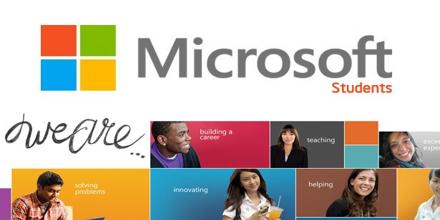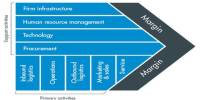Microsoft Student Programs
of Microsoft Bangladesh Limited
Microsoft is a corporation headquartered in Seattle, Washington, USA. Microsoft supports the invention of, manufactures, and licenses goods and services related to computing. It is a multinational computer technology corporation. The history of Microsoft begins in April 4, 1975, when it was founded by Bill Gates and Paul Allen. Its current best-selling products are the Microsoft Windows operating system, Microsoft Office suite of productivity software, Xbox a line of entertainment of games, music and video and Bing, a line of search engines.
In 1980, Microsoft formed a partnership with IBM that allowed them to bundle Microsoft’s operating system with IBM computers, paying Microsoft a royalty for every sale. In 1985, IBM requested that Microsoft write a new operating system for their computers called OS/2; Microsoft wrote the operating system, but also continued to sell their own alternative, which proved to be in direct competition with OS/2. Microsoft Windows eventually overshadowed OS/2 in terms of sales. When Microsoft launched several versions of Microsoft Windows in the 1990s, they had captured over 90% market share of the world’s personal computers.
Ireland became home to one of Microsoft’s international production facilities in 1985, and on November 20 Microsoft released its first retail version of Microsoft Windows (Windows 1.0), originally a graphical extension for its MS-DOS operating system. In August, Microsoft and IBM partnered in the development of a different operating system called OS/2. OS/2 was marketed in connection with a new hardware design proprietary to IBM, the PS/2. On February 16, 1986, Microsoft relocated to Redmond, Washington. Around one month later, on March 13, the company went public with an IPO, raising US$61 million at US$21.00 per share. By the end of the trading day, the price had risen to US $28.00. In 1987, Microsoft eventually released their first version of OS/2 to OEMs. Meanwhile, Microsoft began introducing its most prominent office products. Microsoft Works, an integrated office program which combined features typically found in a word processor, spreadsheet, database and other office applications, saw its first release as an application for the Apple Macintosh towards the end of 1986. Microsoft Works would later be sold with other Microsoft products including Microsoft Word and Microsoft Bookshelf, a reference collection introduced in 1987 that was the company’s first CD ROM product. Later, on August 8, 1989, Microsoft would introduce its most successful office product, Microsoft Office. Unlike the model of Microsoft Works, Microsoft Office was a bundle of separate office productivity applications, such as Microsoft Word, Microsoft Excel and so forth. While Microsoft Word and Microsoft Office were mostly developed internally, Microsoft also continued its trend of rebranding products from other companies, such as Microsoft SQL Server on January 13, 1988, a relational database management system for companies that was based on technology licensed from Sybase.
Product/service offerings
When it comes to Microsoft products they have 13 most important Microsoft product lines and they are:
- Windows: Microsoft’s bread and butter are Windows and despite some who predict its demise, the OS is doing quite well. Microsoft revealed that it has sold 400 million copies of its latest version, Windows 7. Still, Microsoft faces challenges. PC growth is slowing and with the most drastic overhaul ever of Windows planned for Windows 8, it remains to be seen how the market responds to the product’s new tile- and touch-focused UI.
- Office: Anyone who knows anything about Microsoft is aware how important its Office franchise is to the company. Microsoft has shipped 100 million copies of Office 2010 since the product’s release in mid-2010. Despite a long history of stellar growth, consumer licensing of Office dropped 8 percent last year but businesses helped drive Office revenues up 27 percent during the company’s 2011 fiscal year.
- Exchange: While a growing number of customers are offloading their e-mail systems to the cloud, only a small sliver of large enterprises are making the wholesale shift. Exchange remains the most widely adopted enterprise e-mail platform.
- SharePoint: While it has its share of detractors, SharePoint is a billion-plus-dollar business for Microsoft because it lets enterprises share information generated from Office and other sources.
- SQL Server: The database is a key pillar of the Microsoft Server & Tools Business. SQL Server revenues increased 20 percent in fiscal year 2011. On tap for this year is SQL Server 2012, code-named “Denali,” which will push the envelope in terms of support for business intelligence features and support for big data.
- Windows Server: As long as Microsoft is selling lots of SQL Server, Exchange Server, SharePoint and Dynamics, customers need Windows Server. Besides that, of course, Windows Server provides enterprises with their core authentication services through Active Directory and virtualization via Hyper-V, as well as providing the infrastructure for products such as IIS and Windows Storage Server.
- Visual Studio: The latest release, Visual Studio 2010, has enabled thousands of developers to target Microsoft’s latest platforms, including Windows 7, Windows Azure, and Windows Phone 7, as well as the forthcoming Windows 8. “Visual Studio 11” is now in the works.
- Xbox: At last count, Microsoft reported 35 million members of its Xbox Live community. In fiscal year 2011, Microsoft sold 13.7 million Xbox consoles, compared with 10.3 million in 2010. Revenues for the company’s Entertainment and Devices Division hit $2.7 billion, a 48 percent year-over year increase.
- Bing: It will be a long time, if ever, before Microsoft’s search engine can unseat Google as the default search engine of choice. But thanks to Microsoft’s partnership with Yahoo!, Bing has grabbed a 14 percent share of the search market, up 31 percent over FY 2010. Still, Bing and the rest of Microsoft’s advertising and online business continue to lose money to the tune of $2.5 billion, based on revenues of the same amount.
- Dynamics: Microsoft’s portfolio of ERP and CRM software and services is believed to generate more than $1 billion in revenue. While Microsoft is in the process of updating the entire portfolio with cloud and social networking features, the company faces a barrage of rivals in this cutthroat market.
- System Center: Believe it or not, the Microsoft System Center product line also brings in more than $1 billion in annual revenue. Used to manage both hardware and software running in enterprise datacenters, Microsoft just gave the management suite a major refresh. Due out in the first half of this year is System Center 2012, which will add new capabilities to operations and applications management.
- Skype: The newest addition to the Microsoft portfolio, Skype grossed $860 million in 2010, according to its IPO filing, before the company was snapped up. Between the unified communications business of Lync and Skype, Microsoft says it intends to increase the availability of real-time voice and video communications to consumers and enterprises.
- Windows Azure: This is the only product line on the list that probably isn’t even close to generating a billion dollars in revenue. Nevertheless, the Windows Azure platform is clearly an important product line as Microsoft customers and partners transition their systems and apps to the cloud. Its success or failure will have huge implications for Microsoft.
Future plan
There was a time, not so long ago, when Microsoft and computing were synonymous. Since then, Macs have carved out their own slice of the marketplace, and devices like smart phones and tablets have muddied the boundaries of the PC’s reach.
Microsoft is preparing to undo all that.
We’ve all heard the marketing spiel about a unified user experience across Windows PCs, phones, and tablets. Microsoft’s 2015 BUILD keynote assembled all the pieces into one impressive whole. This isn’t just a clever line for an ad campaign; it’s a comprehensive attempt to turn Windows from an OS into multi-platform ecosystem.
Millions of people around the world use Windows for work and at home. However, with the concept of the PC becoming more intangible, Microsoft is clearly aware it could eventually be in trouble if it doesn’t expand. Windows needs to become more than just the OS most use on their PC. Microsoft has known that for years, but now it actually has a workable plan to achieve its goal.
Bringing developers on board: Microsoft wants to offer the same experience to Windows users on their phones and tablets as experienced by those on their desktop computer. A similar experience isn’t enough. Only the real thing will suffice, as proven by Continuum. The devices will matter less and less, because they’re simply conduits to give users access to Windows. Just as you can upload a clip of your best performance in Halo directly from your Xbox One to your OneDrive, or sync a tidbit from OneNote across your phone, tablet and laptop, expect to see your Windows devices become increasingly intertwined. Some might find the trend annoying, but many will love how it makes common tasks easier.
Microsoft made sure to push this movement heavily at BUILD, because the developers in attendance are the ones who will make the company’s vision a reality. Any platform is only as good as the software that can be used on it, and Microsoft are going wide in the hopes of delivering as much quality content to their users as is possible.
We saw plenty of different coding languages producing software for a host of devices during Microsoft’s BUILD keynote, and that wasn’t any coincidence. Whether it’s offering up a more open version of the Office suite with support for custom-made add-ins, or providing an Android emulator as part of Visual Studio, Microsoft is designing tools to make Windows the home of development.
Beyond that, there’s the key element of crossover between Windows 10 on all platforms. Microsoft wants to make it as easy as possible for development to cover PCs, tablets and phones. That goal is to make programming for Windows more appealing, and thus populate the Windows Store with the sort of apps users want to download.
Engaging the audience: With developers committed to the advantages Windows allows them, Microsoft can aggressively court consumers. A well-stocked Store will tempt Windows emigrates back to the OS, and there is already a plan to keep them on board afterwards. Take Cortana, for instance. Personal assistant software still seems likely to capture the imagination of the mainstream, but Microsoft’s version seems to have an underpinning that ties into their aim of broadening the reach of Windows as a whole. Cortana has been touted as an assistant that will learn about user’s habits and interests to deliver the best possible service. We saw a slight twist on that idea in Microsoft’s BUILD keynote, where Joe Belfiore explained some changes to the Windows Lock Screen.
The new Spotlight feature will expand upon promotional efforts to publicize Windows Store content. Users will be able to tell their device what interests them and what doesn’t, similar to the system currently in place as part of the Windows 10 Technical Preview to customize Lock
Screen wallpapers.
On the surface, it’s a minor point, but Belfiore’s wording when demonstrating the functionality might illuminate its greater purpose. He referred to users teaching their device about their preferences, which suggests much more of a relationship than simply checking a box in the Control Panel.
Microsoft is attempting to develop the relationship between users and the Windows OS over time. Between a work PC, a tablet for recreational use and a Smartphone, users will be able to train Windows to fit into their life just as they desire. And once that’s done, it’ll be hard for said users to jump to another OS.
DESCRIPTION OF THE PROJECT
Objective of the project
Primary Objective
The primary objective of preparing this report is to find out the reason “why Microsoft student partners are switching or have intention to switch from Microsoft to Google.”
Secondary Objective
- To discuss Microsoft Student Programs
- To find out whether the initiative and activities of these programs are focused on the purpose.
- To explore the satisfaction level of the students of these programs.
- To observe the possible future opportunities and threats of these programs.
- Based on findings and analysis, to give overall comments.
- To recommend some solution if any major predicament is found
Methodology
This report is exploratory in nature- focusing on both qualitative and quantitative analysis and description.
Population and sample
The population is the entire Microsoft student Partner in Bangladesh. However, for some limitation it was difficult to collect information from all of them. So, in this project around 30% students were considered as sample size.
Source of data collection
Primary source:
- Data has been collected through telephone interview.
- Same questions have been asked to all the students.
- Some data are collected through informal conversation.
Secondary sources:
Secondary data has been collected from official website of Microsoft, Microsoft Student Partner and DreamSpark.
MICROSOFT STUDENT PROGRAMS
Microsoft always gives many opportunities for the students. In addition, Microsoft believes that students are the future developer and user of technologies, software, applications and games. Thus, world-wide there are some programs designed by Microsoft especially for students. Similarly, in Bangladesh, Microsoft helps and gives opportunities to students to build their knowledge about technology through some programs.
In my project I have discussed about two of their programs: Microsoft Student Partner (MSP) and Dream-spark.
Microsoft Student Partner (MSP)
The Microsoft Student Partners is a worldwide recognizable program to sponsor students majoring in disciplines related to technology. The MSP program enhances students’ employability by offering training in skills not usually taught in academia, including knowledge of Microsoft technologies.
The program is available in most countries including, and all students in college and university level are eligible to apply. If accepted, Student Partners are assumed to further share the knowledge among the academic community by, for example, arranging courses, giving presentations and initiating projects.
The MSP Program was initiated in 2001, and operated in 15 countries for five years. In late 2006, the program was expanded to 50 countries worldwide, and as of July 2010, there are more than 2800 members worldwide across 101 countries and regions.
Purpose:
The MSP program is an educational and promotional program to sponsor undergraduate and postgraduate students majoring in disciplines related to technology, typically computer science, computer information systems and information technology. MSP program aims to enhance students’ employability and increase students’ awareness of Microsoft technologies. Student Partners are offered training especially in product-specific skills not typically taught in academia.
The program aims to increase awareness of Microsoft products, programs and initiatives. Consequently, the program helps expanding the user base of Microsoft products, and results in better availability of properly educated workforce in those technologies.
Activities:
Student Partners are given access to the latest Microsoft software, development tools, reference material, industry events, and training opportunities. MSPs are assumed to further share the knowledge among the academic community by arranging courses; giving presentations and lectures; and initiating projects among the students. MSPs are also used to promote incentives, for example, the Microsoft Imagine Cup.
DreamSpark
DreamSpark is a Microsoft Program that supports technical education by providing access to Microsoft software for learning, teaching and research purposes. DreamSpark can kick-start student’s career, giving them the best professional-level design and development tools—at no charge—to literally make their dreams come to life.
Thus, to get the real coding experience student need to build powerful apps, games and web sites so that they can be confidante and self-motivated.
Benefits one can get from DreamSpark:
- DreamSpark is simple and it’s all about giving students Microsoft professional-level developer and designer tools at no cost so that students can chase their dreams and create the next big breakthrough in technology – or just get a head start on their career.
- DreamSpark helps educators teach the latest technologies and experiment in research. Microsoft knows that to make learning more motivating, relevant, and engaging for today’s students requires a diverse set of resources. DreamSpark gives educators the resources to ensure their classrooms always have the latest technologies to challenge, motivate, and keep students engaged in new ways.
- DreamSpark is also a subscription for Academic Institutions and it provides a costeffective way to put Microsoft developer tools, platforms and servers in labs and classrooms, and on their students’ and faculty’s computers for learning and research purposes. It reduces lab costs and teaching budgets.
- Deep resources, expert help, tutorials, sample code, how-to’s, coding camps and contests to help you get your first app published
- Free membership in Xbox Live game portal, Windows Phone Developer Center and Windows Store
Microsoft Virtual Academy (MVA)
With the subscription on DreamSpark a student can get free registration on Microsoft Virtual Academy (MVA). Microsoft Virtual Academy (MVA) is a web-site from where registered students can join online courses, get expert’s help as well as certificate on individual course.
The courses are basically technical courses, for example; web-designing, coding language, game development etc.
Overall Purpose of Microsoft Student Programs:
- Promotional Activities: Through these programs Microsoft expect student to promote their product. When it’s about Microsoft many of the people think that it’s only about windows and Microsoft office. However, there are also other products and services offered by Microsoft. Therefore, Microsoft expects these programs would help the organization to promote their other products and services positively.
- Developing application and games for windows store without any cost: MSP’s are committed to Microsoft to develop and submit their applications and games. For that, they don’t get any financial benefit. On the other hand, when user download those applications and software Microsoft get some benefit which helps them to increase their brand value.
- Positive word of mouth communication: Through these programs Microsoft want to build a positive word of mouth communication. So that, other people, more importantly, next generation can know the values of technological knowledge. Moreover, they can be loyal to Microsoft and influence other with their positive word of mouth communication.
- Decrease piracy in Bangladesh: In Bangladesh, most of us use pirated version software and application. However, it’s a loss other company. As a result, Microsoft wants to convey this message that piracy is illegal and it can be harmful for or day to days working and personal life as well. Therefore, these programs help them to spread this massage easily.
FINDINGS AND ANALYSIS
SWOT analysis of Microsoft Student Programs
Based on the findings, some of strengths, weaknesses, opportunities and threats have been discussed here:
Strengths
- Students are satisfied with service of DreamSpark. In addition, as from DreamSpark student can get chance to download the software and application without any cost, student are so much satisfied with this service.
- In addition, some of the students are now started to using actual version of windows and other software instead of pirated version. So, from this news it can conclude the purpose that to decrease piracy, is actually fulfilled.
- MSPs are satisfied with the training that provided by Microsoft and also satisfied with the working environment. Thus, it is strength for these programs.
Weaknesses
- Some students are leaving because they think that working pressure is very high and it could be harmful for their study.
- Moreover, their social networking site is not that much active. As a result, students are not getting the right information at right time.
- Though they have invested on the events but student are not influenced by their events. Rather friends are the most influential figure for them. Thus, their events purpose is not successful.
Opportunities
- Students are ready to share about DreamSpark among their peers and family as well. Thus, it can be a future opportunities for Microsoft.
- As Bangladesh have already the law of anti-piracy, student can now understand the importance of Microsoft Student Programs, especially, DreamSpark.
Threats
- Some of the students are creating negative word of mouth communication because of the working pressure they have experienced as a MSP.
- Google are trying to give some opportunities for the students in Bangladesh such as, Google android learning jam. Moreover, Google android developer group is already present in Bangladesh and some of the students already switch in Google. So, it is a threat for Microsoft.
- In addition, online courses are not that much famous in Bangladesh. Consequently, students are not interested in Microsoft virtual academy.
Other findings
Source of information
The purpose of the research was to find out the sources those used by Microsoft to convey the message of Microsoft Student programs, how much productive those sources are. Microsoft in Bangladesh is using three main sources by which they want to share the information about their program so that student can join. Those three sources are: events in different universities, friends, and social networking site.
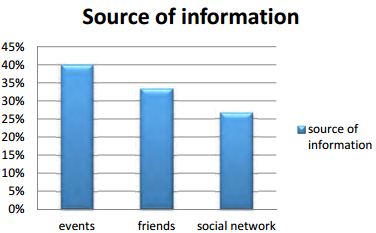
According to the chart it has found that about 40% students get the information from the events, 33.33% from their friends and 26.67% from their social networking site.
Thus, Microsoft needs to give more focus on their events. In addition, positive word of mouth communication should be created as students also get this information from their friends. Finally they should find out some solution to increase their social networking activities.
Influencing issues
There are some major issues those have found which persuade the student to join Microsoft as an MSP. From my working experienced in Microsoft, I found that three things can influence most: events, friends and faculties.
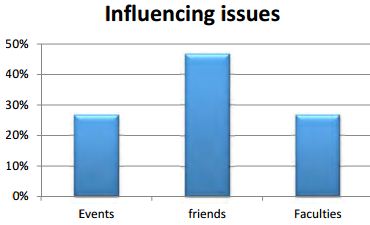
About 47% students are influenced by their friends. On the other hand, events and faculties have similar result. Therefore, again creating positive word of communication is a precious issue. In addition, Microsoft need to influence the faculties as well because as a student I assume that its student mindset that faculties are expert and experienced so if they want us to move forward then we think that definitely we will be benefited.
Knowledge and training provided for Students, working environment and time that student have to spend as an MSP
As an MSP as well as from Dream-Spark students gets technical knowledge and training.
However, whether these training are fulfilling their purpose or not and in my research I wanted to observe that as well. In addition, the working environment is good enough or not and whether the students are satisfied with the time they need to spend as an MSP. I wanted to explore all of these matters in my research as well as their level of satisfaction.
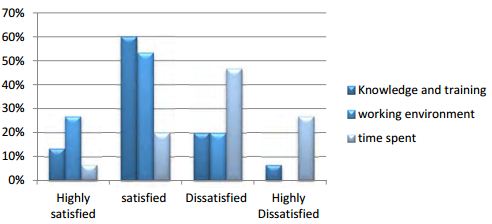
From the chart, it can conclude that students are satisfied with the knowledge and training that provided by Microsoft. However, students might need to spend much time on the work and that might be harmful for their academicals study. Thus, some of them are not satisfied of this MSP program.
DISCUSSION AND RECOMMENDATIONS
The Leaky Bucket Theory
The “leaking bucket” concept models a business as a bucket and customers as the water in the bucket. Therefore, a leaking bucket refers to a business that is losing customers and market share. According to Anne Miner, founder of Calgary, Canada-based consulting firm The Dunvegan Group, “businesses must acquire new customers to compensate for the loss or leakage of existing customers. Leaking bucket marketing is part of a company’s overall customer retention strategy.” (Basu, 2010)
Thus, I have observed that MSPs are switching or have intention to switch to Google. The main reason behind this is the working load of Microsoft. Moreover, students do not get any financial benefit from this program. Therefore, according to leaky bucket theory it can state that Microsoft is losing their member. In addition, some of the students are leaving due to higher education or full time job. So, it is high time they should try to fix their leaking bucket. Here, I have recommended some strategies so that they can solve the problem:
Fixing the Hole
This solution is very simple. As I have already found that students are not satisfied due to working load, Microsoft need to make sure the working load should not be very high and they need to make sure this with their existing student partners. In addition, Microsoft can give them other benefits like reward for best performance. Thus, Existing student will be happy and do not want to switch to Google. According to the Canadian-based consulting firm The Dunvegan Group, “cost five times less than the cost of acquiring a new customer.” (experian corporation , 2009)
Increasing the flow of new MSP
To the flow of new MSP, Microsoft needs to focus on their event. They need to make sure that students are getting right and convincing message from their events. Moreover, as it is already found that almost 47% students are influenced by their friends, Microsoft should concern on positive words of mouth. In fact, faculties are also influenced their students to join Microsoft, therefore, Microsoft could communicate with them and convince them as well.
Speaking with previous MSP
Another strategy can be speaking with previous MSP and try to find whether there is any other problem or not. Moreover, Microsoft can try to explain why the work load was high and also take some suggestion from them. By doing this dissatisfied students will have a feelings that they were the important part of the organization and finally their negative word of mouth communication will convert in positive word of mouth communication
CONCLUSION
Microsoft students programs are really helpful for students and these programs are giving future opportunities for the students in Bangladesh. In addition, through these programs students are getting chance to enhance their resume for future and they are also gets the experience to work with flourishing people of Microsoft. Thus, it will be beneficial for their professional life as well.
However, for some difficulties students are not getting the right message and could not understand the importance of these programs offered by Microsoft, consequently, some of the students are creating negative words of mouth communication. As a result, from the perspective of Microsoft, the organization could miss the future opportunities in Bangladesh. So, it is high time for Microsoft to concern more about this matter and tries to make sure that previous MSPs are not making any negative words of mouth communication and existing MSPs are satisfied with the service they are getting from Microsoft student programs. Finally, Microsoft needs to influence more students to join their programs through other way of communication other than the traditional way.
RECOMMENDATION
- Google has its own brand value like Microsoft. However, Google has not yet started such program like Microsoft expect Google android learning jam which is very new in the market. Thus, Microsoft still have chance to convince the students. For that they should make the working environment friendlier and involve themselves more on organizing different events and workshop in universities.
- In addition, they need to make sure that the existing MSPs are satisfied and make them to create positive words of mouth communications. Moreover, MSPs should spread the news of Dreamspark and other exciting program offered by Microsoft. Thus, other students will be convinced and join Microsoft.
- As online courses are not very much famous in Bangladesh, Microsoft must make sure that the importance of online courses through their events and campaigns in universities. In fact they can puss the MSP to do some online course so that they can get a positive experienced and make themselves convinced to share the summary to others. As a results, student will be influenced by their friends and understand the value of online courses.
- Finally, it is high time for Microsoft Bangladesh to choose other media for communication. For instance, newspaper, billboard, TVC. Because from these media parents can also know about these programs, therefore they can also persuade their children to join Microsoft student programs.
